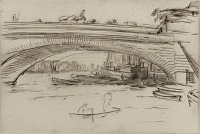Etchings Institutions search term: freer gallery
London Bridge | ||
| Number: | 172 | |
| Date: | 1877 | |
| Medium: | drypoint | |
| Size: | 159 x 235 mm | |
| Signed: | butterfly at lower right (3-final) | |
| Inscribed: | no | |
| Set/Publication: | 'Cancelled Plates', 1879 | |
| No. of States: | 6 | |
| Known impressions: | 24 | |
| Catalogues: | K.153; M.150; W.123 | |
| Impressions taken from this plate (24) | ||
KEYWORD
TITLE
'London bridge' (1877, Whistler). 4
'London Bridge' (1886, Frederick Wedmore (1844-1921))
5
4: i.e. [10 October 1877], GUW #12734.
5: Wedmore 1886 A (cat. no. 123).
DESCRIPTION
SITE
The new stone bridge designed by John Rennie was started in 1824. The foundation stone was laid in 1825 and it was officially opened on 1 August 1831 when HMS Beagle was the first ship to pass under it. It was widened in 1902, and sold to Lake Havasu City, Arizona, in 1970.
The only part of Rennie's bridge that remains in London is that on the south side, spanning the junction of Tooley Street and Montague Close. The present London Bridge opened in 1973. 6
According to the Encyclopedia Brittanica (1911):
6: Peter Murray & Mary Anne Stevens, Living Bridges - The inhabited bridge, past, present & future, Royal Academy of Arts, London, 1996; Patricia Pierce, Old London Bridge - The Story of the Longest Inhabited Bridge in Europe, Headline Books, 2001; Peter Jackson, London Bridge - A Visual History, Historical Publications, revised edition, 2002; The London Bridge Museum & Educational Trust at http:// www.oldlondonbridge.com; www.portcities.org.uk /london; www.victorianweb.org/ photos (all accessed 2009).
DISCUSSION
